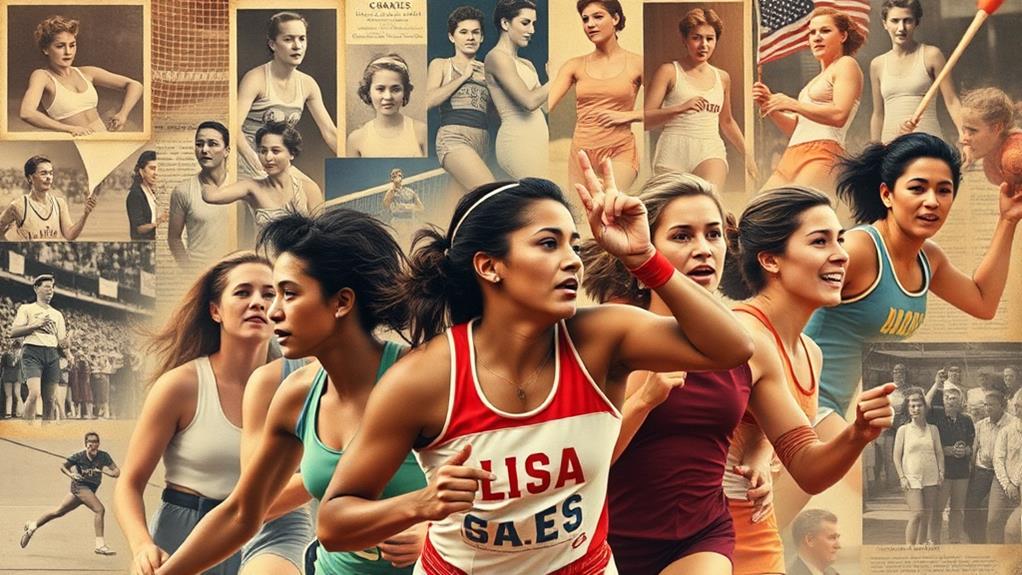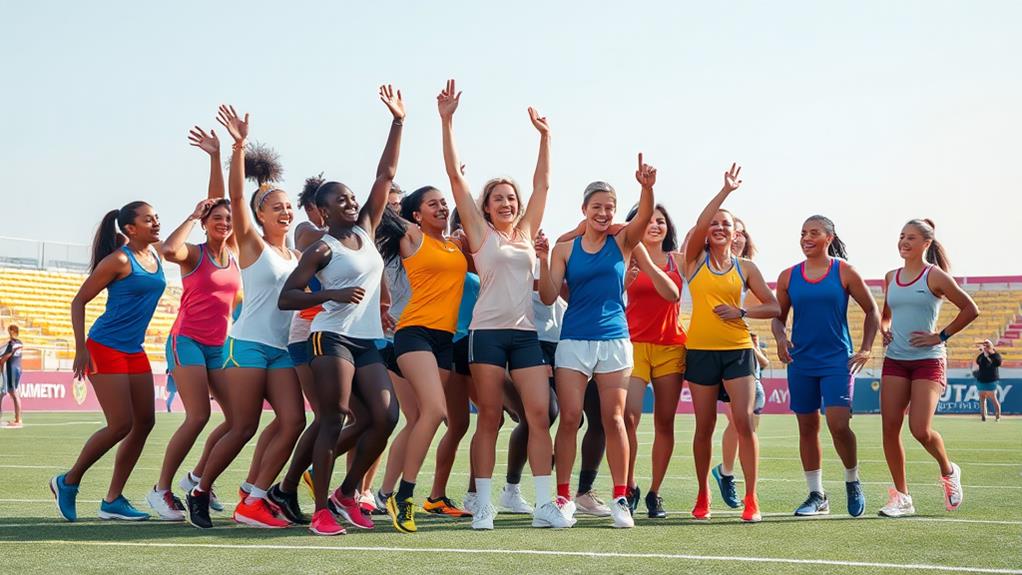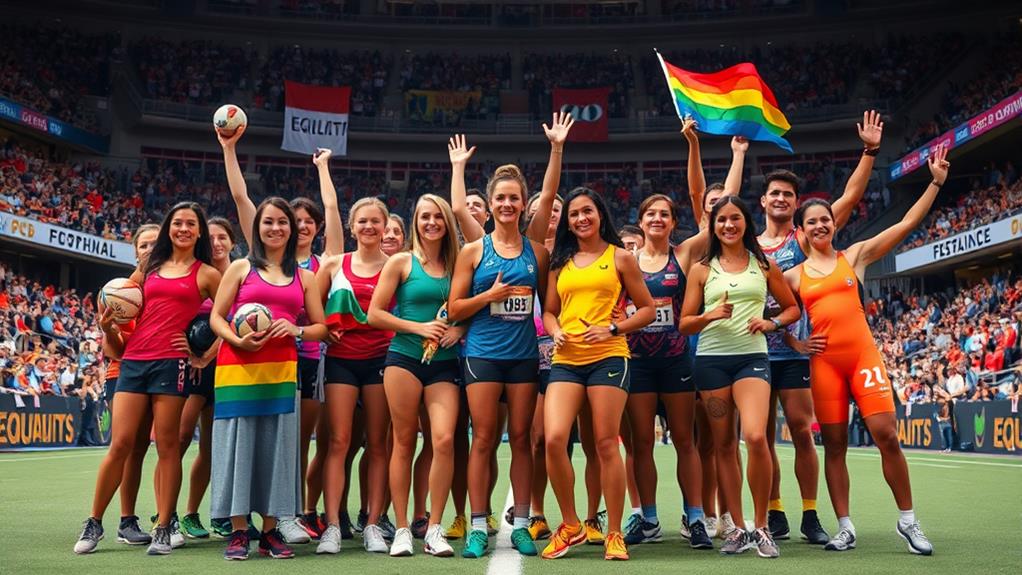Gender equality in sports is crucial. In many countries, girls have limited access to sports compared to boys, reflecting broader societal inequalities. Although there has been progress, with more girls' programs and supportive policies emerging, inadequate funding and media coverage remain significant barriers.
Prominent athletes are driving change. They are raising awareness about gender inequality in sports and inspiring younger generations to take action. For instance, tennis superstar Serena Williams has been a vocal advocate for equal pay and maternal rights in sports.
Gender equity in sports has numerous benefits. It enhances performance, as girls and women who participate in sports tend to have higher self-esteem and better physical health.
It also boosts self-esteem, as girls who play sports are more likely to develop confidence and leadership skills.
Furthermore, it strengthens community ties, as sports can bring people together and promote social cohesion.
Understanding the importance of gender equity in sports is key. By recognizing the challenges and benefits, individuals can contribute to creating a more inclusive sports environment.
This can involve advocating for policy changes, supporting girls' sports programs, and promoting gender equality in local communities.
Historical Context and Challenges

Historical Context and Challenges
Youth sports have often mirrored societal inequalities, particularly regarding gender. Traditional gender norms have shaped the sports landscape, dictating which sports are suitable for female athletes.
This has led to significant gender disparities, with girls facing limited opportunities compared to their male counterparts.
Girls' sports programs typically receive fewer resources and funding, which negatively impacts participation rates and overall development.
These barriers create a cycle of underrepresentation, where female athletes struggle to gain recognition and support. Societal perceptions and stereotypes also play a role, as female athletes often receive less media coverage, perpetuating the existing disparities that discourage participation.
The lack of women in coaching and leadership roles within sports organizations compounds these challenges. Without access to mentorship and support, aspiring female athletes face additional hurdles.
Historical disparities, resistance to change, and systemic funding inequalities remain significant barriers to achieving gender equality in sports. Understanding this historical context is crucial for recognizing the challenges that women in sports continue to navigate today.
Progress and Positive Developments
Gender Equality in Youth Sports: Progress and Positive Developments
Increased Opportunities for Female Athletes
In recent years, significant strides have been made toward achieving gender equality in youth sports, transforming the landscape for female athletes.
Girls' sports programs have expanded, offering more opportunities for participation. This growth is largely due to increased awareness and advocacy, leading to a notable rise in girls' sports teams and leagues.
Inclusive Policies Foster Equitable Environments
The implementation of inclusive policies has improved fair treatment and access, creating a more equitable environment for all young athletes.
This shift has ensured that girls have equal access to sports facilities, coaching, and resources, allowing them to develop their skills and compete on a level playing field.
Women in Leadership Roles
Women are stepping into leadership roles within sports organizations, fostering diverse and inclusive settings that support female athletes' growth.
These leaders are breaking down barriers, paving the way for new initiatives and programs that directly address the needs of young girls in sports.
For example, the National Women's Sports Foundation has established programs to increase girls' participation in sports and provide resources for female coaches.
Improved Media Coverage
Media coverage of women's sports has improved, highlighting the achievements of female athletes and challenging outdated stereotypes.
The increased visibility promotes greater recognition and appreciation of their contributions to the sports world.
Initiatives like the adidas Breaking Barriers Project focus on dismantling systemic obstacles for women and girls in sports, ensuring equal access, safety, and inclusivity across various disciplines.
Cultivating an Environment for Female Athletes to Thrive
These positive developments are crucial for cultivating an environment where female athletes can thrive.
Fostering Gender Equality

Ensuring Equal Opportunities in Youth Sports
To achieve gender equality, young girls must have equal access to participate in various sports activities. Investing in girls' sports programs can improve facilities and resources, leading to higher participation rates.
By addressing funding disparities, we can create a more level playing field.
Challenging Stereotypes through Education and Awareness
Education and awareness campaigns can challenge stereotypes that discourage girls from engaging in athletics. These initiatives promote inclusivity, encouraging more girls to see sports as a viable option.
For example, mentorship programs that pair young female athletes with experienced women in sports can provide crucial support and inspiration.
Empowering Female Coaches as Role Models
Promoting female coaches as relatable role models can foster a more diverse and inclusive coaching landscape. When girls see women in leadership roles, it reinforces the idea that they too can achieve greatness in sports.
This environment can inspire girls to pursue their athletic dreams.
How Does Gender Equality in Sports Contribute to Social Inclusion and Empowerment of Marginalized Groups?
Gender equality in sports plays a critical role in promoting sports and social inclusion. By breaking down traditional barriers, it provides opportunities for marginalized groups to participate and excel. This empowerment not only promotes diversity but also fosters a sense of belonging and acceptance within the community.
Benefits of Gender Equity
Gender equity in sports leads to a broader talent pool and higher performance standards. When boys and girls have equal opportunities to participate, they bring diverse skills and perspectives to the playing field, resulting in improved competition quality.
This, in turn, fosters essential life skills like teamwork, resilience, and leadership that benefit all athletes, regardless of gender.
Gender-inclusive sports environments have a positive impact on mental health and well-being. They promote feelings of belonging and self-worth among young athletes, which is crucial during formative years.
For example, a study found that girls who participate in sports are more likely to have higher self-esteem and body confidence. Accessible sports programs also strengthen community bonds by attracting broader youth participation, fostering understanding and respect through shared experiences.
Achieving gender equality in sports inspires societal changes. By challenging gender stereotypes, we pave the way for future generations to pursue their passions without the constraints typically imposed by societal norms.
For instance, title IX legislation in the United States has led to a significant increase in women's participation in sports, resulting in more female role models and breaking down gender barriers.
In this way, gender equity in sports serves as a catalyst for inclusivity, encouraging everyone to thrive and contribute to a more equitable world.
Advocacy and Activism

Athletes and advocates are driving change in sports equity.
Prominent athletes like Serena Williams and Megan Rapinoe use their platforms to push for gender equity, inspiring fans and fellow athletes to take action. Social media plays a key role in this effort, creating spaces for discussions that highlight women athletes' accomplishments and mobilize support for their causes.
Grassroots movements amplify women's voices in sports.
Initiatives like the adidas Breaking Barriers Project work to dismantle obstacles by promoting equal access and safety in athletic environments. For example, the project provides resources and support to help girls and women overcome barriers to participation.
Similarly, campaigns like UNESCO's #HerMomentsMatter aim to shift media narratives that prioritize male achievements, pushing for more equitable coverage of women athletes.
Advocacy efforts are breaking down barriers to women's participation and visibility in sports.
By fostering a culture of inclusivity and support, we can ensure that future generations of female athletes receive the recognition and opportunities they deserve.
These efforts are crucial, as women still face significant barriers to participation and recognition in sports.
Questions and Answers
What Are the Barriers to Gender Equality in Sport?
Barriers to gender equality in sport are multifaceted and pervasive.
Media representation is skewed towards male athletes, neglecting female achievements. For instance, a study found that only 4% of sports media coverage is dedicated to women's sports. This lack of visibility perpetuates pay disparity, where women earn significantly less than their male counterparts. In tennis, for example, women's singles champions earn 22% less than their male counterparts.
Access limitations also hinder participation and growth. Inadequate facilities and funding for girls' programs are common obstacles. For example, a survey found that 40% of girls' high school soccer teams lack access to a regulation-sized soccer field.
Additionally, girls' programs often receive less funding than boys' programs, making it difficult for them to compete at the same level.
Addressing these issues is crucial for creating an equitable environment that supports all athletes, regardless of gender.
How Are Female Athletes Breaking Barriers?
Female athletes are breaking barriers through empowerment initiatives and visibility campaigns. These programs highlight their achievements and challenge stereotypes, leading to a shift in public perception and increased media coverage.
Increased media coverage addresses sponsorship disparities that often limit women's opportunities.
Athletes like Caitlin Clark and Serena Williams are inspiring examples of this shift. Their talent and dedication prove that gender isn't a limitation. They pave the way for future generations, ensuring a more equitable landscape in athletics.
What Are the Four 4 Main Barriers to Gender Equality?
Four main barriers to gender equality exist: cultural stereotypes, policy limitations, economic disparities, and social norms.
Cultural stereotypes dictate what roles are deemed appropriate for different genders, reinforcing inequality. For instance, women are often expected to prioritize domestic duties over career advancement, limiting their opportunities.
Policy limitations create legal and institutional obstacles that hinder progress. For example, laws that restrict women's access to education or employment opportunities perpetuate inequality.
Economic disparities arise from unequal funding and support, making it challenging for women to access the same resources as men. This is evident in the gender pay gap, where women earn less than men for the same work.
Social norms also play a significant role in perpetuating gender inequality. These norms often justify and normalize discriminatory behaviors, making it difficult to challenge and change them.
Together, these four barriers perpetuate systemic inequalities that are hard to overcome.
What Are the Barriers to Gender Equality in Society?
Social stereotypes are a significant barrier to gender equality. These stereotypes shape our perceptions of gender roles, limiting opportunities for both women and men.
For instance, they may lead people to believe that women are less capable in science and technology fields, or that men shouldn't pursue careers in nursing or teaching.
Economic disparities also hinder gender equality. Unequal pay is a significant issue, with women often earning less than men for the same work.
For example, in the United States, women earn on average 82 cents for every dollar earned by men. Additionally, women often have limited access to resources, such as education and job training, which can further widen the economic gap.
Cultural norms can also dictate behavior and expectations, reinforcing traditional views that hinder progress towards gender equality.
For example, in some cultures, women are expected to prioritize family and childcare over their careers, while men are expected to be the primary breadwinners.
Understanding and addressing these barriers is crucial for fostering a more inclusive and equitable society for everyone.